Integrating Social Networks into Economics Education: Engagement & Research-led Learning
Sofia Izquierdo Sanchez
Senior Lecturer in Economics, University of Manchester
sofia.izquierdosanchez at manchester.ac.uk
William J. Tayler
Senior Lecturer in Economics, Lancaster University
w.tayler at lancaster.ac.uk
Published March 2025
1. Introduction and Motivation
Integrating research and teaching in higher education is a well-established challenge. The pedagogical literature shows that embedding research-led teaching into the curriculum can increase student motivation and academic performance (Kinkead, 2003; Land and Gordon, 2013). In practice, the integration of teaching and research is an issue that requires further analysis in the higher education literature. The optimal combination between research-led and other kinds of teaching has already been studied in the literature without an explicit agreement on whether it would be more beneficial to use a passive or active approach (Griffiths, 2004; Healey and Jenkins, 2009; Zamorski, 2002).
Over the last two academic years, we explored the use of social media to increase engagement and bridge the gap between academic research and student learning. The benefits of the use of social networks in academia have been demonstrated for both students and academics (Meishar-Tal and Pieterse, 2019; Middleditch et al, 2020; Nandez and Borrego, 2013). However, these networks have been mainly used to connect peers, facilitate collaborative learning, or build a community among students. Our approach aims to connect research-led teaching activities, engagement enhancement, and real-world relevance through reels, posts, and case study repositories. This aligns with Generation Z's affinity for Instagram as a valuable educational tool.
In the academic years 2022-2023 and 2023-2024, we introduced an Instagram page (@dailylifeecon) as a supplementary learning tool across four undergraduate economics courses at The University of Manchester and Lancaster University. This initiative aimed to:
- Introduce research-led teaching in an engaging format.
- Increase student participation and motivation.
- Connect economic concepts to students’ real-world experiences.
Our findings indicate a significant positive relationship between student engagement with the Instagram account and improved academic performance, even when accounting for students' past performance and background. The effects are particularly notable for students with specific learning difficulties (SLDs). This case study details how social media was used to enrich economics education at the undergraduate level and the impact it had on students’ learning outcomes.
65% of students thought it would be a very good or good idea to complement traditional teaching with social networks
Note that students were not obliged to follow the page; this was complementary material which they could access on a voluntary basis. Additionally, only content that was relevant to the teaching material was embedded in the teaching interface system.
2. Using Social Media to Implement a Research-Led Curriculum
Social networks, particularly Instagram, have become an integral part of students’ daily lives. To assess the impact of using the account on the student's learning experience, we prepared some pre- and post-exposure questionnaires. 121 students between both universities answered the pre-exposure questionnaire, and 81 students answered the post-exposure questionnaire. Over 93% of the students indicated that they use Instagram on a regular basis; these results match different surveys across different countries regarding Instagram used among Generation Z (see for example, Thomas, 2024). It is also important to highlight that the pre-exposure questionnaire showed that 65% of students thought it would be a very good or good idea to complement traditional teaching with social networks. Even though we decided to use Instagram following the current platform's popularity, the idea is easily transferable to other social networks making it adaptable to future trends in the sector.
Using Instagram’s features—posts, reels (short videos), and stories (24-hour posts)—we provided students with interactive and research-informed content. The account served multiple functions:
- Pre-Lecture Engagement: Stories included quizzes and polls to introduce key topics before lectures.
- Case Study Integration: content linked theoretical concepts to real-world applications, accompanied by case studies accessible through a dedicated website.
- Academic Research Promotion: content providing concise explanations of economic concepts, often linked to academic papers or news articles.
By integrating this approach into the curriculum, we encouraged active learning and made economics more accessible and relatable.
3. Case Studies: Instagram in Action
Case Study 1: Engaging Students Before Lectures
For the Managerial Economics I course, we introduced students to demand estimation and regression analysis through an Instagram poll available 24 hours before the lecture.
Managerial Economics I is a year 2 module taught at the University of Manchester with students from different degrees: BA Economics, International Business Finance and Economics, PPE, and Modern History and Economics.
Students were asked to predict which variables determined student satisfaction with university life. The story made clear that this question was related to the following day's lecture (Figures 1a and 1b) – 97 people replied to the questionnaire before the lecture.
Figure 1a: Story 1a
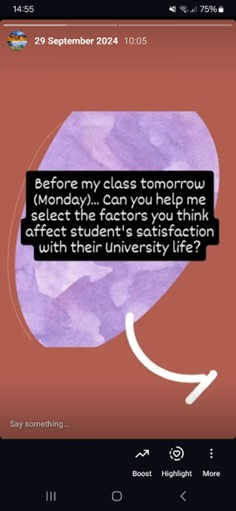
Figure 1b: Story 2
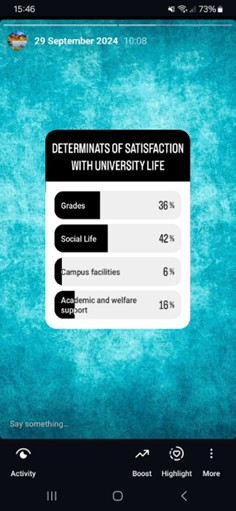
The variables for the model were selected from the most popular responses in the Instagram questionnaire. The following day, we started the lecture with the Instagram story results and asked them to fill in an online questionnaire which asked them to rate their university satisfaction on a scale from 0 to 10, the overall average grade in their previous academic year, and the weekly hours they spend socialising. In class, we analysed their responses using their data, and we drew on the theory of regression analysis and related contents from there, creating a participatory learning experience. Attendance that day was 82%, on average 8% higher than the rest of the lectures.
Case Study 2: Explaining Economic Concepts through Real-World Analogies
We use short videos (reels) and posts to explain concepts we see in class, the using those examples students can access a related case study for further details and explanation. The case studies are accessible via a dedicated resource website which can be accessed via the Instagram profile.
One of the concepts that we see in Microeconomics is Oligopoly. While on holiday on the beach we saw that, when the tide is high, two villages were connected via a boat which had the monopoly of the crossing. We recorded a short video exploring the possibility of a new entrant in the market and the different strategies of the players (Figure 2). For the new entrant, whether to enter or not enter the markets, and for the hotel boat whether to fight or accommodate the new entrant.
Figure 2: Screenshots of the reel


Note: Reels and posts will also have a caption on Instagram where we briefly explain the situation within 2,000 characters and invite the students to access extra resources.
The students can then access further resources, such as a case study in this case, via the resource website, making it a valuable educational resource for both students and educators.
Case Study 3: Connecting Academic Research to Student Lives
It can be difficult for students to engage with research if they don’t see the application or they don’t understand the relevant concept. We also use the different features of Instagram to link content to relevant academic articles.
For example, we had to sell a car in the second-hand market (Figure 3), we use this situation in our daily lives to explain the adverse selection. Students where then linked to the academic paper of Akerlof “The Market for “Lemons”: Quality Uncertainty and the Market Mechanism”.
Figure 3: Picture of the post
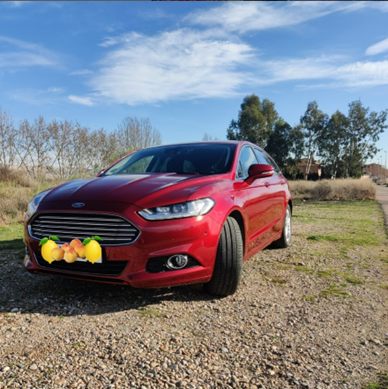
Note: Reels and posts will also have a caption on Instagram where we briefly explain the situation within 2,000 characters and invite the students to access extra resources.
See a full list of Posts and Reels related to academic articles or specialised magazines.
4. Impact on Student Engagement and Performance
To assess the effectiveness of Instagram in supporting learning, we analysed student interactions and academic outcomes. We had data on students' performance in the current modules and past related modules, and we could observe engagement with the account both passive and active engagement (such as likes or comments). Using econometric analysis (OLS and Probit regression models) our results highlight that
- Higher engagement with the Instagram account is positively correlated with improved academic performance, even when controlling for students’ past performance in the related modules.
- Followers of the Instagram account had better percentile ranks in their courses compared to non-followers. If a post or reel was directly relevant to the course content, then it was embedded in the virtual learning platform used at the University. The account is also open, so you don’t have to be a follower to access the content. However, followers of the account are more regularly exposed to the content due to the Instagram algorithm.
- The results were particularly relevant for students with specific learning difficulties (SLDs) benefited significantly, showing increased engagement and better performance.
After the first year running, some societies and students started to contact us for collaboration in posts or videos. Sometimes, we are also tagged on relevant content. Furthermore, we observe engagement with the account outside the university term. We can also see general engagement data with the linked website of further resources, where students can access case studies, a glossary of economic concepts, and further resources relevant to students and educators. We observe that engagement with the website of resources has progressively increased. Graph 1 shows engagement over the past academic years.
Graph 1: Resources Website User Engagement
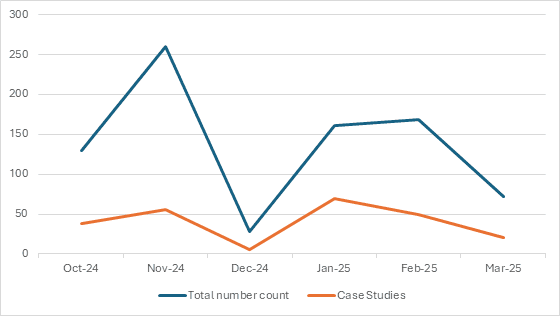
Note: The academic teaching term at the University of Manchester and Lancaster University in 2024/2025 runs from late September to mid-December and from late January (final exams for the first semester took place in mid-January) to the end of April 2025. This data was collected on March 19th, 2025, so the data for March in the graph doesn’t show the full month. The website offers different resources, such as complementary case studies, content linked to academic articles, a glossary of economic concepts, or access to different events we organise. The total number count represents the aggregate total number of visits to all the sections in each month.
The post-exposure survey revealed that 64% of students found the content helpful in understanding economic concepts, and 60% felt it helped them relate economics to real-world issues, making the content learnt in lectures more accessible. Some of the most common words on the written feedback were creative, approachable and relatable. (Figure 4)
Figure 4: Word-Cloud written feedback comments
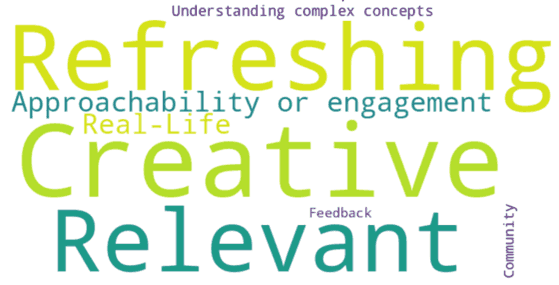
Further details of the analysis and data used can be found in Izquierdo Sanchez and Tayler (2025).
5. Conclusions: Lessons and Future Applications
This project demonstrates that social media can be a powerful tool in economics education. By incorporating Instagram into the curriculum, we successfully:
- Increased student engagement through interactive, visually appealing content.
- Enhanced understanding of economic concepts by linking theory to everyday life.
- Bridged the gap between research and teaching, making research more accessible to students.
- Supported diverse learning needs, particularly benefiting SLD students.
This approach is easily transferable to other social media platforms and disciplines. @dailylifeecon's success underscores the potential of blended learning and digital engagement strategies to complement traditional economics teaching methods.
References
Griffiths, R. (2004). “Knowledge production and the research-teaching nexus: The case of the built environment and disciplines”, Studies in Higher Education, 29, 709-726. https://doi.org/10.1080/0307507042000287212
Healey M., and Jenkins A. (2009). Developing undergraduate research and inquiry [Report]. The Higher Education Academy
Izquierdo Sanchez, S., and Tayler, W. (2025). “The Use of Social Networks to Improve Student Engagement and Implement a Research-Led Curriculum”, Economics Working Paper Series Lancaster University: 03/2025
Kinkead, J. (Ed.)(2003). “Valuing and Supporting Undergraduate Research”, New Directions in Teaching and Learning, San Francisco: Jossey-Bass.
Land, R., and Gordon, G. (2013). “Enhancing Quality in Higher Education: International Perspectives”, Routledge.
Meishar-Tal., and Pieterse, E. (2019). “Why Do Academics Use Academic Social Networking Sites?”, The International Review of Research in Open and Distributed Learning, 18(1): 1-22. https://doi.org/10.19173/irrodl.v18i1.2643
Middleditch, P., Moindrot, W., and Rudkin, S. (2022). “Teaching with Twitter: An Extension to the Traditional Learning Environment”, International Review of Economics Education, 41: 100252 https://doi.org/10.1016/j.iree.2022.100252
Nandez, G., and Borrego, A. (2013). “Use of Social Networks for Academic Purposes: A Case Study”, The Electronic Library, ISSN: 0264-0473: https://doi.org/10.1108/EL-03-2012-0031
Thomas, M. (2024). “Where does Gen Z Spend most of their Time Online?”, Social Media Marketing News.
Zamorski, B. (2002). “Research-led Teaching and Learning in Higher Education: A Case”, Teaching in Higher Education, 7(4): 411-427 https://doi.org/10.1080/135625102760553919
↑ Top
